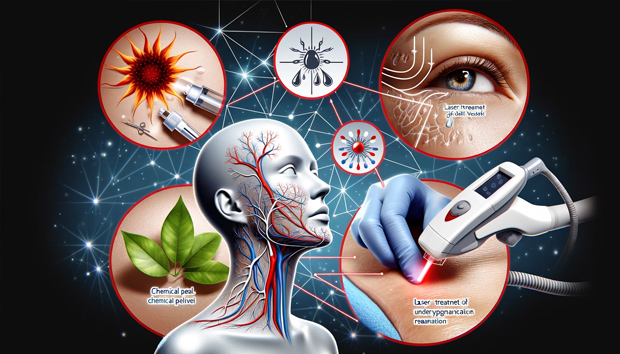There are various types of procedures that help us fight scars, pigmentation and formations on the skin, fine wrinkles, and irregularities, but some of these procedures are better to be postponed until the autumn-winter period, as they violate the integrity of the upper layer of the skin. skin that, under the summer sun, has a predisposition to the formation of new hyperpigmentation. Some of these treatments are chemical peels, fractional CO2 lasers, other types of lasers, Morpheus 8, etc.
Chemical peel
Chemical peeling is a procedure that fights pigment spots and imperfections on the skin of the face. Used to remove specified layers of the epidermis and dermis. A chemical peel, at its core, is the action of one or more ingredients applied to the skin.
Regardless of the type of chemical peel, the procedure is quick, non-invasive, and painless. The only sensation is a slight burning and tingling sensation. With deeper chemical peels, reddening of the skin is possible, which disappears after a few days. Chemical peels remove dead skin cells from the surface of the skin, stimulating renewal and improving its functioning. The relief is leveled, the pores are narrowed, fine wrinkles are erased and age spots are eliminated.
A week after the procedure, intensive exfoliation of old and damaged skin begins, this is, in fact, the effect of chemicals on cells, which leads to their exfoliation, active regeneration, and the appearance of new skin devoid of imperfections. Chemical peels require that the area is not tanned, for example, after that, you should not be in the sun for several weeks.
Contraindications to the procedure are the presence of viral skin infections, somatic diseases, open or fresh wounds on the face, during pregnancy and lactation, and very sensitive and thin skin. It is not recommended to do this in the summer, before the upcoming exposure to the skin of ultraviolet rays. This can cause unwanted effects such as hyperpigmentation and greatly prolong the recovery process.
Laser treatment of dilated vessels
During the Nd: YAG laser procedure, a light pulse is delivered to the blood vessels, the energy of which is absorbed by hemoglobin in the blood. The walls of unwanted vessels “stick”, which leads to their destruction. The blood flow is redirected to the vessels located deeper. Usually, the procedure is carried out with a cooling nozzle, which reduces discomfort. The duration depends on the number, density, and area of the processed vessels, the processing of single capillaries takes place in seconds.
The number of procedures depends on the type, color, and quantity of dishes. Sometimes two procedures are enough, but with several vessels, more is required. The interval between procedures is approximately two months. After treatment, the vessels do not reappear, but if there is a predisposition, new vessels may appear in the already treated areas that are subject to the new treatment.
After the procedure, redness and swelling of the treated area may occur. It is not used in the presence of active sunburn, when using a solarium before the procedure when taking anticoagulants, and in uncontrolled diabetes mellitus.
Fractional CO2 laser
Scars can be removed by several methods, with fractional CO2 laser being preferred due to its controlled effect only on the affected areas. During the procedure, not all skin is injured, but only its individual sections called microthermal zones. Each such area is surrounded by a healthy and unaffected area. This greatly reduces the recovery period. The production of new collagen fibers is activated, which restores the structure, density, and elasticity of the skin. It is used to remove acne scars, smallpox, and postoperative scars, combat fine wrinkles, and tighten the skin.
Redness and swelling of the skin appear immediately after the procedure. In the following days, a brownish crust forms, and exudate may leak out. During this period, it is recommended to cleanse the skin with clean water and use moisturizers and sunscreens, which contribute to faster skin recovery. It is forbidden to remove the formed crust from patients, as well as use scrubs, and be in the sun and strong wind. Therefore, the most suitable season for the procedure in winter.
After CO2 laser treatment, it takes about 2 months for the skin to replace the damaged collagen layer. The effect is visible already in the first week after the procedure but continues to develop over the next few months. The fractional laser is not suitable for bacterial and viral skin infections, pregnancy, breastfeeding, and epilepsy.


Leave a Reply